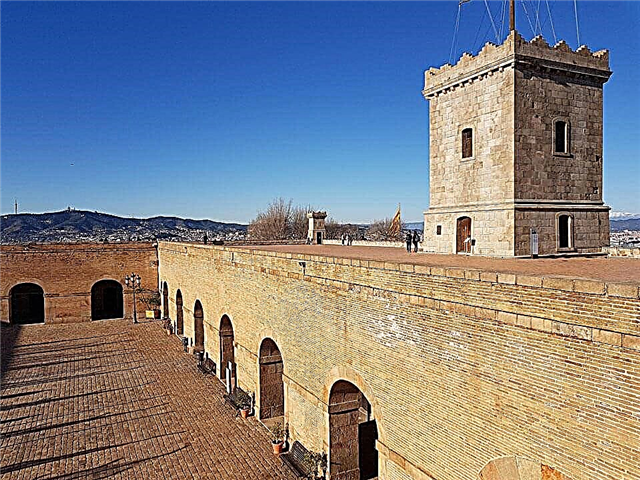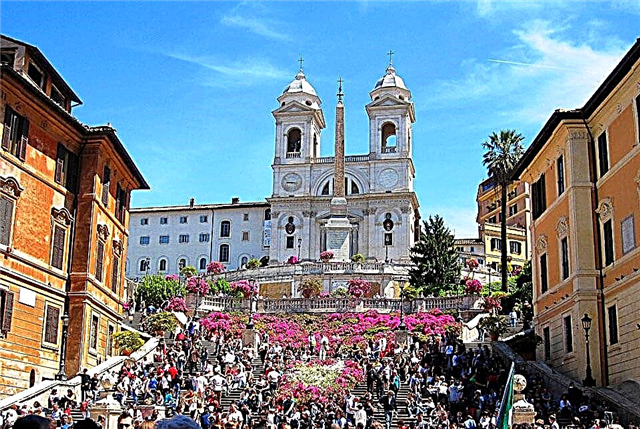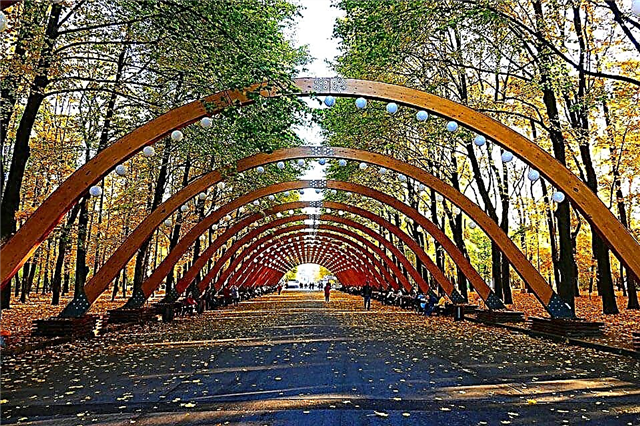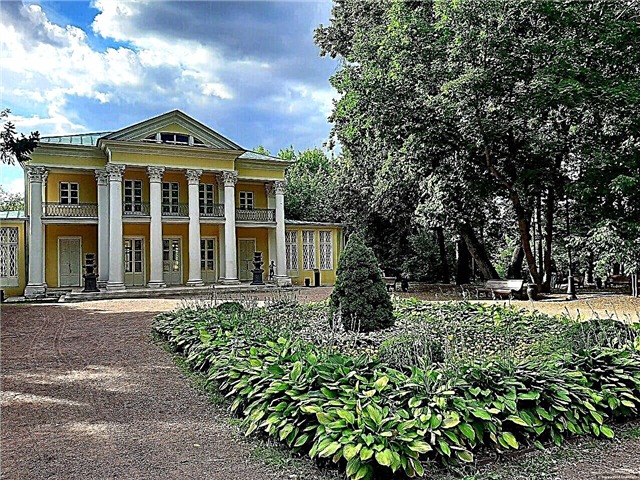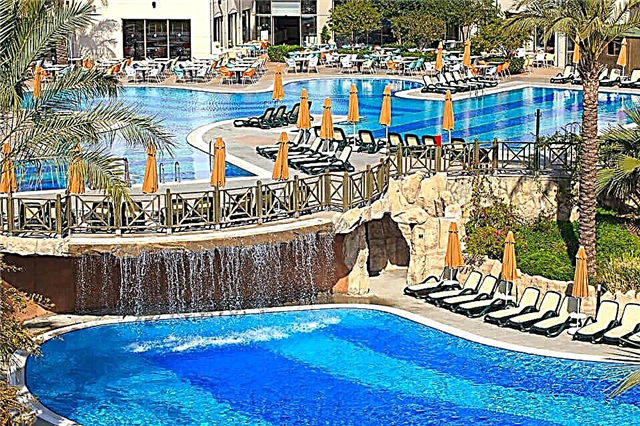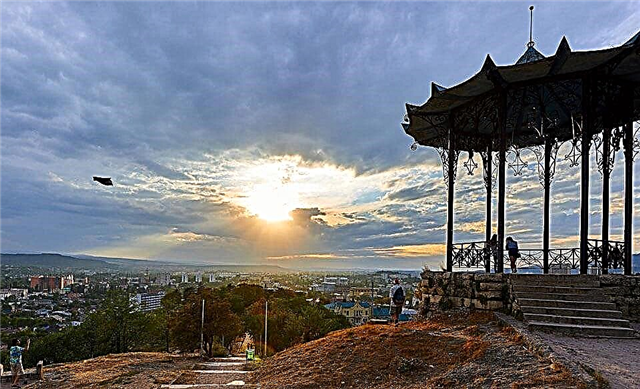Italy had a tremendous influence on the architecture and planning of the resort town, which did not prevent Pyatigorsk from acquiring its unique look. Numerous tourists celebrate the special homely atmosphere that reigns on its territory. The sights of Pyatigorsk do not differ in European gloss, but the city has what is called a living soul. Local cuisine is a mix of traditional Caucasian, Cossack, Ukrainian, Jewish, German, Polish dishes. Clean air, silence, majesty of mountains, beauty of the surrounding nature set you up for relaxation. Yes, the infrastructure of health facilities, sanatoriums, hospitals still needs to be improved. The city has prospects of becoming a health resort of the European, world level. Residents have a chance of success precisely because they managed to preserve the main thing: love for their small homeland. This great feeling is the driving force behind any successful transformation.
Lake Proval

Mystics consider the natural well on the slope of Mashuk mountain to be a place of power. The cave of the same name, at the bottom of which there is a turquoise lake 11 meters deep, resembles a funnel in its shape. A 50-meter artificial tunnel leads to it. Near the cave there is an observation deck, a spring with healing drinking water, cafes and souvenir shops. The amazing cave was once visited by Alexander Pushkin, Mikhail Lermontov, Lev Tolstoy.
Monuments next to it were erected at different times. Chief among them: lions and Ostap Bender. Many believe that touching the sculpture of the "great schemer" will bring wealth. The icons in the cave are modern copies of miraculous images. Sightseers admit: after visiting Proval, it is easier to make important decisions. There is a completely logical explanation for this phenomenon: in a minimal amount, natural sulfur, when it enters the body, activates the work of the brain.
Aeolian harp

The famous gazebo is closely associated with the Mikhailovsky spur of Mount Mashuk. It attracts romantics, lovers and everyone who wants to admire Pyatigorsk, its surroundings, the top of Elbrus. The observation deck was equipped 200 years ago and since then has retained its popularity among guests and residents of the city.
The devices of pre-revolutionary and Soviet aeolian harps, on which the wind made melodic sounds, have not survived. They were replaced by acoustic equipment. The structure was regularly reconstructed, which allowed it to keep its appearance as close as possible to the original. The gazebo resembles a small antique temple; in the dark, illumination lights turn it into a fantastic jewel.
Lermontov's grotto

The grotto is located in the eastern part on the Mashuk mountain, a stone path leads to it. The attraction appeared on the city map in the first half of the 19th century. Initially, there was a natural grotto at this place. It was enlarged and named after the nymph Calypso, whose cult in ancient times was associated with life and death, and not only the legends about the adventures of the traveler Odysseus.
After 30 years, the picturesque cave was renamed in memory of the Russian writer. Local residents, guides say: Mikhail Lermontov often visited it in search of inspiration or ... amorous adventures, because the grotto is romantic. There is a small observation deck next to the cave, from where a magnificent view of the city and its surroundings opens.
The place of the duel M.Yu. Lermontov

Mikhail Lermontov was not famous for his angelic behavior: he was distinguished by insane courage, was a gambler, a red tape, an inveterate duelist, a caustic interlocutor. There are legends: he knew the day and hour of his death, therefore he was in a hurry to try everything in life. One thing is certain: the St. Petersburg fortune teller Charlotte Kirchhoff predicted to the poet that the trip to the Caucasus would be the last and named the signs of the second duelist. Lermontov refused to believe, and Frau was not mistaken.
Fatal glade eventually entered the city limits. Temporary monuments have been erected on this section of Mashuk Mountain several times. Today there is an obelisk in which a bust of Lermontov is located. The monument looks impressive. Each of its elements, including the figures of vultures and heavy metal chains, remind of eternity and unsolved secrets associated with the death of the 26-year-old poet.
Lermontov gallery

The Concert and Exhibition Complex is located on the territory of the Tsvetnik park. The opening of the gallery at the beginning of the last century was timed to commemorate Mikhail Lermontov. The main materials for the building are metal and glass. The gallery is interesting because it harmoniously combines elements of Victorian architecture and various styles: Romanesque, Gothic, Art Nouveau.
When you look at the building, you get the feeling of lightness and flight. Its interior and exterior are dominated by light colors. The history of the gallery is closely connected with the names of Vladimir Mayakovsky, Fyodor Chaliapin, and other famous people who contributed a treasure to the development of Russian and Soviet culture. The exhibition complex is recognized as one of the city's business cards.
Park "Flower garden"

The park is a place of attraction for tourists and townspeople. Its full name was "Nikolayevsky flower garden". In Soviet times, they got rid of the first word so that it would not remind of Emperor Nicholas I, under whose rule in Pyatigorsk the swamps were drained and the park was laid. The history of the sight is connected with the name of Alexander Pushkin, who walked along the alleys here.
Today, most of the sights are located on the territory of the park, including: the concert and exhibition complex "Lermontov Gallery", A.A. Gukasov, mud treatment complexes "Ermolovskie baths" and "Lermontovskie baths", Diana's grotto, a bronze sculpture of an eagle, a monument to Kisa Vorobyaninov. This location allows for a couple of hours of walking to get acquainted with the unique corners of nature and buildings, admire fountains, luxurious flower beds, and majestic trees.
Diana's grotto

The name of the artificial cave reminds of the beautiful ancient goddess of the moon and the hunt, who did not favor men (and everyone who dared to disturb her peace after bathing). It was in this grotto that Mikhail Lermontov visited shortly before his death in a duel. Initially, the cave was built in honor of the first conquest of Elbrus by climbers in the 19th century. In memory of the event, cast-iron slabs with descriptions of the exploits of the expedition were made.
When the grotto was completely built, it became clear: the name "Elbrus" did not suit him. Next to the cave there was a department where women took healing baths, which suggested the idea of a goddess. To this day, the grotto has been preserved almost in its original form. Locals believe: he is in a place of power. After visiting the cave, even skeptics notice how the mood improves, the state of health, the vitality is understood.
Cable car

The cable car to Mount Mashuk was opened in the 70s of the last century. It works daily, with two cabins moving along its route. Each of them has a capacity of 20 people. The structure belongs to the category of pendulum structures, whose construction is considered very difficult, because it provides for the presence of only two supports.
Length of the cable car route: just under a kilometer. The one-way trip lasts 3 minutes, but this is enough time to admire the mountains and the city from a bird's eye view. In the infrastructure of the cable car, for the convenience of travelers, there is a hamburger restaurant located at the lower station (on Gagarin Boulevard).
Academic gallery

In the place of a white stately building, to which a staircase leads, there were originally wooden galleries. Earlier (at the beginning of the 19th century), a healing spring was discovered on this territory, whose value was officially recognized by medicine. The gallery got its name in honor of the wife of Emperor Alexander I. Mikhail Lermontov brought the lepta to the popularity of the building: he, unknowingly, promoted the gallery in the novel A Hero of Our Time.
The structure was erected to provide a comfortable stay for the privileged public. Italian houses of the late Renaissance period became the model for the gallery. Against the background of the Mashuk and Goryachaya mountains, it looks like an outlandish cloud. Its purpose was repeatedly changed, and then the healing source disappeared. Today, this building houses a museum dedicated to insects. The gallery mainly serves as an observation deck and a favorite selfie spot for tourists.
Gate of the Sun

The second name of the unique building is "The Gate of Love". This stone arch is not a monument of antiquity. It appeared on the map in the 90s of the last century. In a difficult time for Russia, when everything was crumbling, the arch became a symbol of faith in family values and hope for changes for the better.
It is here that the newlyweds demonstrate the strength of their feelings, the grooms carry the brides in their arms. Those who have not found a soul mate always strive to pass under the arch in the hope of soon meeting love. Outwardly, the building looks modest, does not differ in fancy decor. The arch consists entirely of stones and seems to be the work of mother nature, and not the people who created such a miracle.
Chinese gazebo

The graceful structure resembles an ancient Buddhist temple or an outlandish exotic flower. It seems to be the embodiment of lightness and something unearthly. The history of the sight is very sad ... The first gazebo was completely destroyed in the last century (after the revolution). Supporters of the new government smashed stained-glass windows, smashed a structure, whose beauty can be judged today by memoirs and old photographs stored in museums and private collections.
In the 70s, a new one was built on the foundation of the pre-revolutionary pavilion. She immediately became one of the most popular places for romantic meetings. Basically, this observation deck for visiting is chosen by those who know how to appreciate the beauty of nature, enjoy the height, plunge into a state of contemplation, harmony with the world. However, the vandals with their "wise thoughts" got here too, they actively "decorate" the monument with autographs in the style "Vasya was here". All attempts to stop the appearance of inscriptions on the gazebo have so far been unsuccessful.
Fountain "Fairy Tale"

The fountain has several other names "Giants", "Gnomes", "Grandfathers". All of them are associated with the fairy-tale world, because we are talking about guardian grandfathers who (according to the beliefs of different peoples) protect natural resources, underground treasures and people themselves from various misfortunes. The dates of the construction of the fountain differ due to the fact that the first decades of its existence were accompanied by reconstructions, making adjustments to the water supply system. It is noteworthy that the "karma of a hydraulic structure" remains the same to this day!
From the images of grandfathers there is a special magic. The faces of the fairy tale characters are strict and at the same time kind. When it gets dark and lights up, they seem completely real. There is always a pleasant atmosphere around the fountain. The murmur of water sounds peaceful. You can stay next to an amazing fountain for hours: dream, take a break from the hustle and bustle, set yourself up for something positive.
Pyatigorsk Museum of Local Lore

One of the oldest museums in Stavropol has its history since the beginning of the last century. Today, his funds and expositions are located in the pre-revolutionary building of the former Mikhailov hotel. The museum contains over 135 thousand antiques. It has its own collections, which allow organizing dozens of unique thematic exhibitions every year.
In the halls of the museum you can see cold arms and firearms (the oldest examples date from the 17th century), coins, jewelry, furniture, dishes, clothes. A special place in his collections is occupied by collections of rare books, postcards, photographs. "Guardians of Eternity" bit by bit restore the rarities associated with everyday life, the life of the Cossacks and mountain peoples. The local history museum is famous for its library and art gallery. Connoisseurs of painting from all over the world come to Pyatigorsk to see canvases by Russian and foreign artists of the 18th-20th centuries, original contemporary masters.
State Museum-Reserve M.Yu. Lermontov

The museum began operating in 1912. Its heart is a whitewashed hut - a small house with a reed roof. The poet rented 2 rooms in it. It was here that he lived before his last duel and wrote immortal poems. Today the museum (its collection is 58 thousand items) occupies a quarter. The buildings located next to the hut became part of the memorial complex.
The old houses carefully recreate the atmosphere of the time when the poet lived in Pyatigorsk. The main value of the museum's collections: they consist of genuine things that belonged to the genius of Russian literature. On the territory of the memorial, there are permanent expositions where you can see Lermontov's manuscripts, portraits and sculptures of the legendary personality, collections of illustrations for the poet's works, listen to music written in his poems.
Insect museum

Located in the premises of the Academic Gallery. Its main collection includes about a thousand butterflies and insects. The first ones live in a specially equipped greenhouse, where exotic flowers grow. The museum was opened in the 90s of the last century, it was created by the famous entomologist Valentin Tikhonov. He is the owner of the exhibits presented in the building, including live spiders, cockroaches, scorpions, tropical beetles, lizards, frogs, and snakes.
The museum is open daily. His expositions are designed for an audience of different ages. The African imperial and Caucasian motley scorpions, the Asiatic snake Eva Braun, which eats three rats in one sitting, and the blue-tongued skink are recognized as real favorites of visitors. A visit to the museum helps to get rid of fears of snakes and insects, because not all of them are dangerous to humans.
Planetarium

The building was opened in the 60s of the last century in the Kirov Park of Culture and Leisure. After 40 years, the building was closed for reconstruction and only in the new century was it opened to visitors. Today the planetarium plays the role of an educational center, whose main goal is to popularize the achievements of Russian astronautics. The state institution is unique in the sense that it is also a small science museum, where you can see a photo collection with images of solar eclipses.
The innovative equipment makes it possible to create three-dimensional images of stars, planets, galaxies in the main hall. Sessions in the planetarium are designed for an audience of different ages. They cover a wide range of topics: from the origin of the universe, the Mayan astronomical calendar to Vedic literature about space, the secrets of ancient earthly civilizations and possible futures where dinosaurs rule the world.
Sculpture "Eagle"

The bird figure - the most recognizable symbol of the city - is located on the territory of the famous "Flower Garden" park. The plot of the sculptural composition is symbolic and simple: the eagle grabbed a poisonous snake and tormented it with its claws. The monument was often attributed to political overtones, which is why it constantly suffered from vandals.
The sculpture on the observation deck, which offers stunning views of the mountains and the resort town, was created at the beginning of the last century. She survived numerous destruction, restoration and remains to this day the main mascot of the city. The eagle symbolizes strength, wisdom, courage, courage, health.Naturally, those who want to acquire such important qualities tend to be photographed next to him.
Gukasov's coffee shop

Externally, the building, located in the Park "Flower Garden", resembles an outlandish ship that sails into a magical land. Initially, the coffee house was intended for vacationing aristocrats and representatives of the merchant class, but ironically, after the revolution, it served as a canteen for workers. The establishment of the famous Baku pastry chef Arshak Gukasov opened its doors to visitors in 1909 and did not flourish for long.
The owner of the coffee shop was repressed and died in Siberia. New visitors destroyed the unique interiors of the building, arguing that all these were symbols of tsarism. The original exterior of the coffee house has been preserved miraculously. Its current owners are doing everything possible to bring a pre-revolutionary entourage into the interior and return the institution to its former glory. Here, as under Gukasov, excellent coffee is brewed and delicious pastries are baked.
Singing fountain

There are two buildings with the same name in the city: near the Flower Garden Park and on Lenin Square. Each of the fountains is interesting in its own way. The first has been operating since the 70s of the last century. In the 90s, he was threatened with the fate of turning into ... a huge trash can. In 2015, the Armenian National Community invested in its reconstruction. Significant changes were made to the design of the sides, the work of the structure. This is how patrons and new technologies restored the fountain to a decent look.
The construction on Lenin Square looks more ambitious; earlier there was a fountain in its place. After the reconstruction, he "sang" and "danced". Show lovers prefer to come to this attraction in the evenings. The spectacle turns out to be bright and impressive. The fountain nozzles move to the beat of the music, the backlight shines with colorful lights. The show takes place on weekends during the warmer months. Each performance lasts 10 minutes, followed by a half-hour break.
Spassky cathedral

The main city temple and the area around it are not ancient monuments. This building is an exact copy of the cathedral blown up in Pyatigorsk in the 30s of the last century. The construction of the first temple is associated with the crowned Romanov dynasty, Nicholas I expressed the desire for the cathedral to have five domes and comply with the canons of the Byzantine style.
When you look at the new building, you get the feeling that it is the "younger brother" of the Moscow Cathedral of Christ the Savior. Such was the old cathedral, whose construction caused a scandal and a 13-year trial. The temple literally collapsed before our eyes, and it had to be rebuilt immediately. The current cathedral is striking in its grandeur and rich interior decoration. One of the main relics of the temple: a stone cross. It was in the foundations of an old building and survived an explosion in the 30s.
Kirov park

Residents of the city call the park the most comfortable and picturesque in the Stavropol Territory. It is mainly chosen for family vacations. The park has a pond with swans, a zoo, kiosks with sweets, a cafe and a restaurant, a fortress town, an autodrome, a mirror maze, a climbing wall, two Ferris wheels - small and large.
Some attractions function only during the warm season, others - constantly. In winter, there is a skating rink, where children and adults enjoy their leisure time. The park was officially opened in the 50s of the last century; in its design you can find many elements of the Stalinist Empire style. However, the history of the recreation area began much earlier: at the beginning of the 19th century, the Kazenny Garden existed on this site. The buildings belonging to him have not survived, and some of the trees have survived.
Pirogov baths

The medical complex was built at the beginning of the last century in 3 months. The architecture of the one-storey building corresponds to the canons of neoclassicism and resembles an antique temple. A mosaic panel can be seen on the facade of the building. Baths were decorated with similar decorative elements in ancient Rome. The building is designed so that more than 20 people can simultaneously take health baths in its premises.
A special mechanism was created to supply and heat water (it was collected in the Aleksandrovsky spring). Later, communications were laid to the Narodny source and the Varvatsievskaya well. The internal layout of the building and its exterior have been changed several times. In Soviet times, a bust of Nikolai Pirogov and a memorial plaque were installed near the entrance to the complex. The outstanding surgeon often visited Pyatigorsk, promoted methods of wound healing with the help of mineral water, made a significant contribution to the development of the resort.
Komsomolsky park

The park was founded in the 60s of the last century. The large-scale development of the Belaya Romashka microdistrict led to the fact that the residents of multi-storey buildings faced a problem: there was nowhere to walk with their children. The park was landscaped literally by the whole world. Sculptures for him were created by a veteran of the Great Patriotic War, the famous Stavropol self-taught sculptor G.M. Minkin. Someone will consider the park too ideologized, but it was a reflection of its time, people's faith in the bright future of the largest state on the planet.
A visit to the unique complex gives you the opportunity to touch the Soviet period of the country's life. The park has modern facilities, including children's playgrounds, a tennis court, and a cinema. However, its patriotic component is incomparably more important. The park keeps the memory of the first local Komsomol members, heroes of the Great Patriotic War, liquidators of the consequences of the accident at the Chernobyl nuclear power plant.
Square named after L.N. Tolstoy

The city square is located in the center. It is pleasant to relax here from the hustle and bustle. Known far beyond the Stavropol Territory, a flower bed with a calendar of fresh flowers is located right here. The square can hardly be called classic - rather, its landscape design solutions tend to eclecticism. From spring to autumn, you can admire the fresh flowers of all shades of the rainbow.
The square is a favorite selfie spot for tourists and locals alike. In winter, it is also picturesque. An artificial spruce decorated with tangerines adds a "zest" to its decoration. The miracle tree is a kind of standard for garden decor in the Art Nouveau style. The austere bust of the Russian classic installed in the park only emphasizes the joyful light atmosphere of the picturesque corner of the city.
Folk baths

Natural depressions filled with water have another name: "Shameless Baths". In Pyatigorsk and its environs there are many hydrogen sulfide springs, where those who care about health rather than developed infrastructure and the benefits of civilization prefer to swim. Before the revolution in the North Caucasus, access to the paid baths was open to a privileged, wealthy public. Petty officials, merchants, burghers, servants, workers could not afford to visit such establishments. Bathing in places where strangers could see a naked person was considered the height of shamelessness.
The reputation threat did not stop the supporters of folk baths. The appearance in everyday life of baths for poor townspeople, where it was possible to stay for free up to 2 hours per visit, did not change the situation. Nowadays, the demand for natural baths is due to cost savings. The most famous folk baths are located near Lake Proval, next to the "Tales of the East" cafe. Healers, healers, specialists in the field of hydrotherapy believe: wellness procedures in natural conditions are much more effective than those performed in buildings and enclosed spaces.




